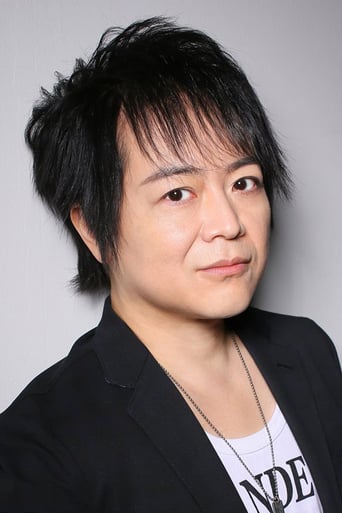Kattiera Nana
I think this is a new genre that they're all sort of working their way through it and haven't got all the kinks worked out yet but it's a genre that works for me.
Pluskylang
Great Film overall
Dynamixor
The performances transcend the film's tropes, grounding it in characters that feel more complete than this subgenre often produces.
Jenna Walter
The film may be flawed, but its message is not.
Irishchatter
This movie is set in the "Grave of the Fireflies" era and its basically about a girl who is telling the story when she was very young during World War 2. The anime has the nice slow moving pace from the early 40s to the mid 40s but then, it slowly creeps up on you as the war was beginning to be at its worst! I simply as a viewer of this movie, was not ready for the worst like you wouldn't even think of it until it does happen!I was abosuletely heartbroken and very upset that Kayoko's family including her baby bro & grandmother, were perished when the Amercians invaded the Tokyo village. It was a miracle that herself and her brother Kisaburou were the only ones alive. Although they were seperated for a bit when he had a job of cleaning deployed soliders shoes and it was even sadder that Kisaburou didn't want to talk to her. I suppose employment was still at its decline after the war and like it was one of the worst events that humanity ever experienced! I felt sick to my stomach that we get to see near the end that Kayoko had to see her home burnt down to the ground. An 11 year old or anybody in Japan that time, didn't deserve this mistreatment. Why is all I can ask here....Brilliant anime, very very sad just like the "Grave of the Fireflies". May all who have died during World War 2 in Japan, rest in peace <3
michael-bungay
After reviewing 'Grave of the Fireflies' (1988) and the 'Barefoot Gen' films (1983 and 1986), I am reviewing the 1991 film 'Who's Left Behind? - Kayoko's Diary'. Now the film has had a limited release outside of its native Japan and is only available in its original Japanese format. I am composing this review to the best of what I know from watching the film on YouTube with the obvious limitations of not being able to understand written or conversational Japanese.The film focuses on 6 year old Kayoko who lives in Tokyo with her parents Otokichi and Yoshi, her Grandmother and older brothers Tadayoshi, Takejiro and Kisaburo. Kisaburo is particularly close to Kayoko and they remain strong allies throughout the film despite the occasional torments that Kayoko's brothers subject her to. The fact that Kayoko is the first and only girl to be born into the Nakane family is the main reason why her brothers sometimes torment her.The time period begins in 1940 and gradually progresses to the Tokyo fire-bombing on March 9th-10th 1945. At first, the impending threat of World War 2 is the least of Kayoko's worries as she has enough trouble fitting in at school and home as she gets upset and intimidated very easily, causing great embarrassment to herself and her family.As time goes by, the threat of War increases and so do Kayoko's responsibilities as her mother becomes pregnant with her 5th child around about 1941 or 1942. This means another brother named Konosuke for Kayoko so she handles the responsibilities of being an older sibling reasonably well apart from nearly losing Konosuke because she is distracted spending time with her friends.The War soon takes precedence over everything else that once mattered as the Nakane family regularly show their support for the Great Japanese Empire and donate several of their most treasured possessions to help with the War effort. Indeed, by about 1943 or 1944, Kayoko is evacuated into the countryside of rural Numazu to go and live with her Aunt and has to leave her entire family behind.Kayoko's evacuation proves well-timed as the film grows ever more darker in tone as the War situation rapidly turns against Japan and in favour of the invading American Armed Forces. Kayoko is already homesick enough as it is and regularly writes to her family back in Tokyo but the worst is still yet to come and all that she has been through up until now pales into insignificance by comparison as soon as 1945 comes along.The first sign of how much the situation has deteriorated comes when Kayoko, her Aunt and all their neighbours retreat into the forests for cover as a fleet of American B-29 Super-fortress bombers fly overhead. As soon as Kayoko realises the American bombers are flying towards Tokyo, her heart immediately goes out for her family and wonders with a great sense of dread what is going to happen to them. Not long after this, Kayoko narrowly escapes being shot by a low-flying P-51 Mustang but a soldier on his bicycle is not so lucky. Kayoko then receives a visit from the injured Kisaburo who has come to tell her of the devastating fire-bomb attack on Tokyo and what it means for him and his sister. The now 11 year old Kayoko and her Aunt subsequently return to Tokyo and stay in a bunker on the outskirts of the destroyed city. At this point Kayoko realises the full extent of how lucky she was to be evacuated.Overall, the film proves to be worth far more than its limited release outside of Japan suggests. It does take a while to properly get going in terms of emphasising just how devastating the effects of War can be, and certainly much longer than 'Grave of the Fireflies' and 'Barefoot Gen' but still does an effective job of proving such a point. The animation quality definitely benefits from being nearly a decade more up to date than the first 'Barefoot Gen' but is still not quite up to Studio Ghibli's standards. Because the film attempts to cram just over half a decade into 90 minutes, much of the focus is on Kayoko and her family trying to go about their everyday lives whilst supporting the War effort as much as they can right up until the evacuation scene. This proves rather poignant as well as an ominous sign of the terrible things to come as Kisaburo runs for a great distance alongside the passenger train on which Kayoko is travelling to Numazu, trying to say a lot more than just a long goodbye.The fact that the film is relatively slow for the most part actually works in its favour as it serves to show how much Kayoko grows and matures as a person over time. For instance, when Kayoko wakes up in the aforementioned bunker, she bumps her head on the low ceiling and simply rubs it with no fuss. This is a significant change from the early stages of the film where Kayoko cries like a baby over simple things. It is when Konosuke is born when Kayoko's maturity starts to gradually develop as she is now no longer the youngest child of the family even if she remains the only daughter.On the whole, if you have already seen 'Grave of the Fireflies' and the 'Barefoot Gen' films then this film will just feel like repetition and the lack of subtitles and translation will further put-off a non-Japanese audience. However given the chance, the audience will find the gradual progression to the outbreak of War on the civilian side of Japan in this film a much more refreshing approach than those of it's 1980's counterparts. As if this film is not already hard enough to find there is also an even rarer remake made in 2005 to look out for.





